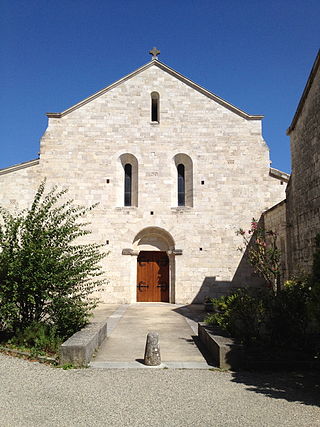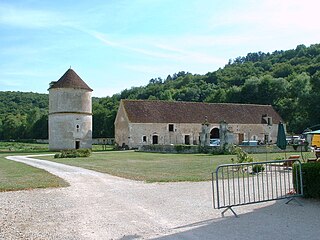
Cîteaux Abbey is a Catholic abbey located in Saint-Nicolas-lès-Cîteaux, south of Dijon, France. It is notable for being the original house of the Order of Cistercians. Today, it belongs to the Trappists.

The Trappists, officially known as the Order of Cistercians of the Strict Observance and originally named the Order of Reformed Cistercians of Our Lady of La Trappe, are a Catholic religious order of cloistered monastics that branched off from the Cistercians. They follow the Rule of Saint Benedict and have communities of both monks and nuns that are known as Trappists and Trappistines, respectively. They are named after La Trappe Abbey, the monastery from which the movement and religious order originated. The movement began with the reforms that Abbot Armand Jean le Bouthillier de Rancé introduced in 1664, later leading to the creation of Trappist congregations, and eventually the formal constitution as a separate religious order in 1892.

Orval Abbey is a Cistercian monastery founded in 1132 in the Gaume region of Belgium, located in Villers-devant-Orval, part of Florenville, Wallonia in the province of Luxembourg. The abbey is well known for its history and spiritual life but also for its local production of the Trappist beer Orval and a specific cheese.

Val-Dieu Abbey is a former Cistercian monastery in Wallonia in the Berwinne valley near Aubel in the Pays de Herve.

The Abbey of Notre-Dame des Neiges or Our Lady of the Snows is a Cistercian monastery in the Ardèche département of south-central France. The former Trappist monastery has been resettled by Cistercian nuns in 2022. The abbey was built in 1850, located on the territory of the commune of Saint-Laurent-les-Bains, about one and a half miles east of the village of La Bastide-Puylaurent (Lozère).

Aiguebelle Abbey is a Trappist monastery situated in the communes of Montjoyer and Réauville in the département of Drôme, on the borders of the Dauphiné and of Provence, France.

Sept-Fons Abbey, Notre-Dame de Sept-Fons or Notre-Dame de Saint-Lieu Sept-Fons is a Trappist monastery at Diou in Bourbonnais in the diocese of Moulins in France. Around ninety monks currently live in the monastery, many of whom are novices sent from monasteries around the world.
The Abbey of Notre-Dame du Lac, known as the Oka Abbey, was a Trappist Cistercian monastery located in Oka, Quebec. The main monastery building is of grey stone; it has a dozen outbuildings, all of which are situated on a 270-hectare property. With a decline in the number of monks by the early 21st century, the monastery decided to end operations there and established a non-profit centre at the abbey to preserve the site's heritage.

La Trappe Abbey, also known as La Grande Trappe, is a monastery in Soligny-la-Trappe, Orne, France. It is known for being the house of origin of the Trappists, to whom it gave its name.
Tamié Abbey is a Cistercian monastery, located in the Bauges mountain range in the Savoie region of France.

Arcis-le-Ponsart is a commune in the Marne department in northeastern France. It is located along the D25 road, south of Courville, 32.2 kilometres (20.0 mi) by road southwest of Reims. The commune of Arcis-le-Ponsart has an area of 15.4 square kilometres (5.9 sq mi). The local economy is mainly agricultural based. Igny Abbey lies in this commune.

The Trappist Abbey of Rochefort or Abbey of Notre-Dame de Saint-Rémy, which belongs to the Cistercians of Strict Observance, is located in Rochefort in the province of Namur. The abbey is famous for its spiritual life and its brewery, which is one of few Trappist beer breweries in the world. Life in the abbey is characterised by prayer, reading and manual work, the three basic elements of Trappist life. The motto of the abbey is Curvata Resurgo.

Soleilmont Abbey is an abbey of Trappistine nuns situated in the forest and commune of Fleurus, at Gilly near Charleroi, Belgium, founded, according to tradition, in the 11th century, which became Cistercian in 1237. The nuns were expelled as a consequence of the French Revolution in 1796, but soon re-established themselves in 1802. The community became Bernardine in 1837, and Trappist in 1919.

Reigny Abbey was a Cistercian monastery in Vermenton, department of Yonne, Bourgogne, France.

Signy Abbey was a Cistercian abbey located in Signy-l'Abbaye, Ardennes, France. It is located about 65 kilometres (40 mi) northeast of Reims and about 28 kilometres (17 mi) west of Charleville-Mézières on the edge of the Froidmont forest. It was founded on 25 March 1135, the feast day of the Annunciation. It was sold as national property in 1793 and completely demolished. Its library was burned.

Guerric of Igny was a Cistercian abbot. Little is known about his early life. He may have been educated at Tournai's cathedral school, perhaps under Benedictine monk, Odo of Cambrai. Guerric appears to have lived a life of prayer and study near the Tournai Cathedral. His monastic formation was directly influenced by Bernard of Clairvaux, who praises him in several letters. In 1138, he became abbot of Igny Abbey, in the diocese of Rheims, a house dependent on Clairvaux. Here Guerric ruled as abbot until his death on 19 August 1157. It was here that he composed the 54 liturgical sermons that constitute his surviving works.

The Abbey of Our Lady of Atlas is a Catholic monastery of Trappists, inaugurated on March 7, 1938, in Tibhirine, close to Médéa, in Algeria.
Augustin Marre was a French Roman Catholic Archbishop, and Trappist abbot.















